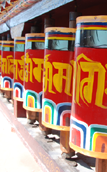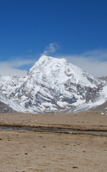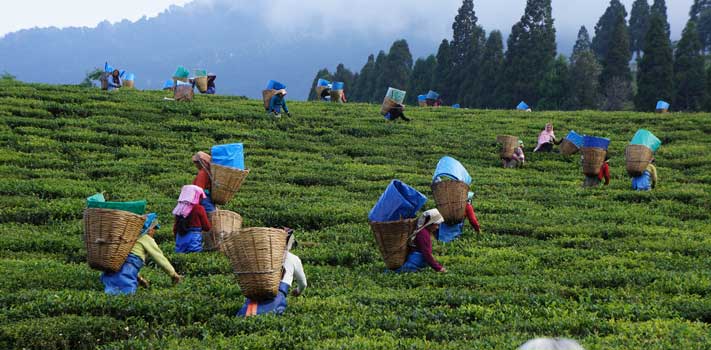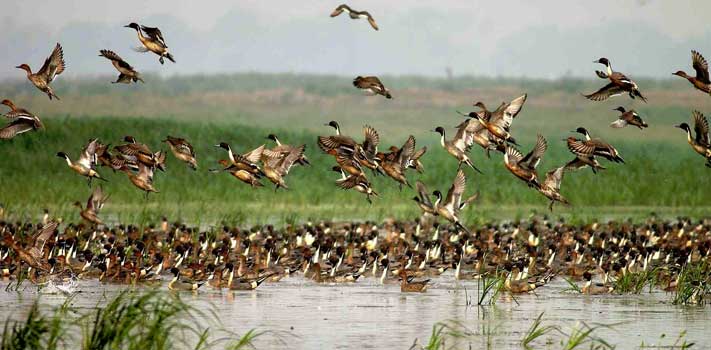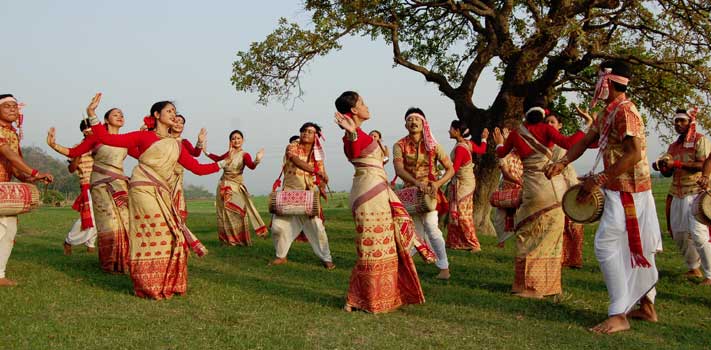About Sikkim-Darjiling
- Yuksom:
This was the first capital of Sikkim and the base camp for trek to the famous Mt. Khangchendzonga. The historical records say that the first divine ruler of Sikkim was sanctified in 1641 by the three learned lamas. The evidence of the ceremony is still present in Norbugang Chorten. The place is considered sacred since the history of Sikkim began from here. It’s also the base camp for the trek to the famous Mt. Khangchendzonga. - Tsomgo Lake:
The lake is about a kilometer long, oval in shape and is considered very holy by the locals. Between May to August, the lake area is spectacular with a display of rare flowers including the primulas, iris and blue & yellow poppies. The lake has a number of aquatic and aerial species and is a perfect habitat for the red panda. The lake freezes in winter. - Nathula Pass:
The pass at an altitude of 14200 ft, is located on the Indo-China border and connects Sikkim to Tibet Autonomous Region in China. The journey itself is an exhilarating experience, with mist covered peaks, zigzag roads and roaring waterfalls, the passage is simply amazing. Visitors are required to get a permit to visit the place. - Pelling:
At an altitude of 6800 ft, it’s the most excellent place to get a closest view of the world’s 3rd highest peak Mt. Kanchendzonga. Apart from the innate beauty of the place, other attractions in Pelling are the Sanga Choeling Monastery, Pemayangtse Monastery and the Khecheopalri Lake. - The Rumtek Monastery:
This magnificent monastery is among the top tourist attractions in Sikkim. It provides as a residence for the 16th Gyalwa Karmapa. The Monastery features some of the extraordinary works of art. The Golden Stupa is the most significant segment of the monastery. - Do-Drul Chorten:
Built by the head of Nyingma order of Tibetan Buddhism in 1945, it has one of the most beautiful Stupas of Sikkim consisting of 108 prayer wheels. It stores various Mandala sets, a set of relics and some other religious possessions. Statues of Gurus are also present there. - Jawaharlal Nehru Botanical Garden:
Established in 1987 the Jawaharlal Nehru Botanical Garden is situated near Rumtek Monastery and is looked after by the Forest Department of the Sikkim Government. The garden is distinguished by enchanting lush woodlands of Oak, different kinds of trees and orchids.
Sikkim Research Institute of Tibetology: It is a nationally well known centre of Tibetan Studies & Research. The institute is renowned for its huge collection of rare manuscripts, Buddhist books and icons. The building is an excellent example of Tibetan architecture, surrounded by small forests of oak and birch trees. The institute also houses religious works of art and amazing silk embroidered paintings.
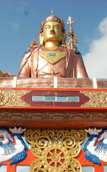 History
History The history of Darjeeling is intertwined with that of Sikkim, Nepal, British India, Bhutan and Bengal. Until the early 19th century, the hilly area around Darjeeling was controlled by the kingdom of Sikkim, while the plains around Siliguri were intermittently occupied by the Kingdom of Nepal, with settlement consisting of a few villages of Lepcha and Kirati people. The Chogyal of Sikkim had been engaged in unsuccessful warfare against the Gorkhas of Nepal. From 1780, the Gorkhas made several attempts to capture the entire region of Darjeeling. By the beginning of 19th century, they had overrun Sikkim as far eastward as the Teesta River and had conquered and annexed the Terai. In the meantime, the British were engaged in preventing the Gorkhas from overrunning the whole of the northern frontier. The Anglo-Gorkha war broke out in 1814, which resulted in the defeat of the Gorkhas and subsequently led to the signing of the Sugauli Treaty in 1815. According to the treaty, Nepal had to cede all those territories which the Gorkhas had annexed from the Chogyal of Sikkim to the British East India Company (i.e. the area between Mechi River and Teesta River). Later in 1817, through the Treaty of Titalia, the British East India Company reinstated the Chogyal of Sikkim, restored all the tracts of land between the Mechi River and the Teesta River to the Chogyal of Sikkim and guaranteed his sovereignty.
Geography
Darjeeling is the main town of the Sadar subdivision and also the headquarters of the district. It is located at an average elevation of 6,710 ft (2,050 m) in the Darjeeling Himalayan hill region on the Darjeeling-Jalapahar range that originates in the south from Ghum. The range is Y-shaped with the base resting at Katapahar and Jalapahar and two arms diverging north of the Observatory Hill. The north-eastern arm dips suddenly and ends in the Lebong spur, while the north-western arm passes through North Point and ends in the valley near Tukver Tea Estate. The hills are nestled within higher peaks and the snow-clad Himalayan ranges tower over the town in the distance. Kanchenjunga, the world's third-highest peak, 8,598 m (28,209 ft) high, is the most prominent mountain visible. In days clear of clouds, Nepal's Mount Everest, 29,029 ft (8,848 m) high, can be seen.
The hills of Darjeeling are part of the Mahabharat Range or Lesser Himalaya. The soil is chiefly composed of sandstone and conglomerate formations, which are the solidified and upheaved detritus of the great range of Himalaya. However, the soil is often poorly consolidated (the permeable sediments of the region do not retain water between rains) and is not considered suitable for agriculture. The area has steep slopes and loose topsoil, leading to frequent landslides during the monsoons. According to the Bureau of Indian Standards, the town falls under seismic zone-IV, (on a scale of I to V, in order of increasing proneness to earthquakes) near the convergent boundary of the Indian and the Eurasian tectonic plates and is subject to frequent earthquakes.
Culture
Apart from the major religious festivals of Dashain (Durga puja), Tihar (Diwali) and Christmas the diverse ethnic populace of the town celebrates several local festivals. The Lepchas and Bhutias celebrate new year in January, while Tibetans celebrate their new year, Losar, in February–March. The birthday of the Buddha is celebrated in mid-June with processions. Darjeeling Carnival, initiated by a civil society movement known as The Darjeeling Initiative, is a ten-day carnival held every year during the winter with portrayal of the Darjeeling Hill's musical and cultural heritage as its central theme.
A popular food in Darjeeling is the Nepalese and Tibetan momo, a steamed dumpling containing meat cooked in a doughy wrapping and served with clear soup and achar. A form of Tibetan noodle called thukpa, served in soup form is also popular. Other commonly eaten dishes include alu dum, a potato preparation, and shaphalay, Tibetan bread stuffed with meat. Fermented foods and beverages are consumed by a large percentage of the population. Fermented foods include preparations of soybean, bamboo shoots, milk and Sel roti, which is made from rice. Tea is the most popular beverage, the Tibetan version is also drunk. Alcoholic beverages include Tongba, Jnaard and Chhaang, variations of a local beer made from fermenting finger millet.
Colonial architecture characterises many buildings in Darjeeling, exemplified by several mock Tudor residences, Gothic churches, the Raj Bhawan, Planters' Club and various educational institutions. Buddhist monasteries showcase the pagoda style architecture. Darjeeling is regarded as a centre of music and a niche for musicians and music admirers. Singing and playing musical instruments is a common pastime among the resident population, who take pride in the traditions and role of music in cultural life.
Darjeeling also has a Peace Pagoda built in 1992 by the Japanese Buddhist organisation Nipponzan Myohoji.
Economy
The two most significant contributors to Darjeeling's economy are tourism and the tea industry. Darjeeling tea, due to the unique agro-climatic conditions of Darjeeling, has a distinctive natural flavour, is internationally reputed and recognised as a geographical indicator. Darjeeling produces 7% of India's tea output, approximately 9,000,000 kilograms (20,000,000 lb) every year. The tea industry has faced competition in recent years from tea produced in other parts of India as well as other countries like Nepal. Widespread concerns about labour disputes, worker layoffs and closing of estates have affected investment and production. Several tea estates are being run on a workers' cooperative model, while others are being planned for conversion into tourist resorts. More than 60% of workers in the tea gardens are women. Besides tea, the most widely cultivated crops include maize, millets, paddy, cardamom, potato and ginger.
Darjeeling had become an important tourist destination as early as 1860. It is reported to be the only location in eastern India that witnesses large numbers of foreign tourists. It is also a popular filming destination for Bollywood and Bengali cinema. Satyajit Ray shot his film Kanchenjungha (1962) here, and his Feluda series story, Darjeeling Jomjomaat was also set in the town. Bollywood movies Aradhana (1969), Main Hoon Na (2004), and more recently Barfi! (2012) have been filmed here. Tourist inflow into Darjeeling has been affected by the political instability in the region, and agitations in the 1980s and 2000s have hit the tourism industry hard.
